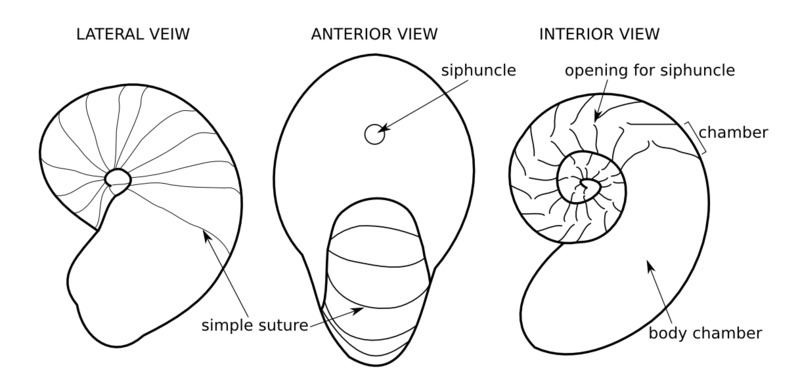- Home
- Rocks
- Type fossils
- Fossil Specimens
- Minerals
- Glossary
- Stratigraphic Chart
- Michel-Levy Chart
- Classification of igneous rocks
- University of Cambridge
- Department of Earth Sciences
- ESC Library
- Moodle
- Sedgwick Museum
- DoITPoMS
- Mindat.org
- Microfossils
- Bryozoans
- Webmineral
- Tree of Life
- CrystalMaker
- Virtual Microscope
Nautiloid
Title
Nautiloid
Description
Taxonomy
Phylum: Mollusca
Class: Cephalopoda
Diagnostic features
Simple suture
Chambers
Central siphuncle
Straight, curved or coiled shell
Stratigraphic range
Cambrian to recent
Straight forms: Cambrian to Permian
Coiled forms: Devonian to Present
Way of life
Nektonic (jet propulsion)Predatory
Buoyancy controlled by changing gas/liquid contents of chambers
Marine
Preservation
Commonly preserved as internal moulds
Modern nautiloids preserved with original shell material
Learn about types of preservation
Advanced notes
Nautiloids originated in the Cambrian period, and radiated during the Ordovician. These early nautiloids had conical shaped shells. In the Silurian some nautiloids used curved shells, and by the Devonian some were coiled. The evolution of the coiled shell from the straight is thought to be driven, at least in part, by increased mobility of a coiled shell compared to a long straight one.
Nautiloids could be confused with ammonoids. You can distinguish them by the location of the siphuncle and the complexity of the suture pattern. Nautiloids, unlike ammonoids, are not extinct, although only six species remain today (compared to thousands in the Palaeozoic). This means that if presented with modern shell material it is likely a nautiloid and not an ammonoid.
Specimens
External links
Collection
Citation
“Nautiloid,” 1A Collections, accessed April 9, 2024, https://wserv3.esc.cam.ac.uk/p1acollections/items/show/113.

